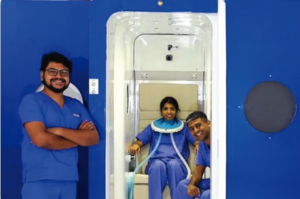art of healing cancer cervical test page1
excerpt
heading 2
cnt2
heading 3
cnt3
Why Choose Art of Healing Cancer

Blending traditional and modern treatments, we offer a holistic approach to cancer care.
Through chemosensitivity planning, we customize chemotherapy to each patient’s unique needs.
Precision and improved outcomes are hallmarks of our state-of-the-art robotic surgery techniques.
Utilizing genomic and transcriptomic data analysis, we provide the most advanced targeted therapy options.
As the only institution in India combining genomic and transcriptomic data with natural and herbal treatments, we offer comprehensive care.
We offer the most advanced immunotherapy treatments, including tailored vaccines and sensitivity testing to immunotherapy drugs.
One of the only centres trained on exploiting tumor Metabolism
We can grow cancer cells from blood in 3D tumors to analyse the cancer characteristics
heading 4
cnt4

DR. MANDEEP SINGH MALHOTRA
- Surgical and Molecular Oncologist is the Chief Mentor at Art of Healing Cancer, with over 20 years of clinical oncology experience.
- He is MBBS(MAMC) and MS Surgery (GMC)
- Trained in surgical oncology at All India Institute of Medical Sciences, Delhi, and gained international experience in the UK, USA, and Europe during his Fellowships in Head Neck Oncology; Breast Oncoplasty; Robotic Surgery and Molecular Oncology Certification
- Experienced Robotic Surgeon, he is one of the pioneers for Robot Assisted Functional Breast Preservation.
- Molecular Oncology Certification from RGCC College Europe
- Expert in Advanced and Recurrent Cancer Treatment, utilizing Precision Oncology Techniques such as NGS, Transcriptomics, Tumor Vialbility assays and mapping them to plan Chemotherapy, Immunotherapy and Traditional / Off label medicine & Metabolic Therapy

DR. MOHIT SAXENA
- Senior Consultant in Medical Oncology with over 10 years of experience at Marengo Asia Hospitals, Gurugram.
- Holds MBBS and MD degrees from Sawai Man Singh Medical College, Jaipur; specialized in Medical Oncology from Gujarat Cancer & Research Institute, Ahmedabad.
- Expert in immunotherapy, various chemotherapy techniques (intravenous, intrathecal, oral), targeted therapy, precision medicine, and hormone therapy.
- Skilled in treating cancers of the head & neck, breast, lung, GI tract, hepatobiliary system, and genitourinary organs.
- Published multiple papers in respected national and international journals on cancer research.
- Previous roles include Artemis Hospital and C.K. Birla Hospital, highlighting extensive clinical experience.
- Known for research in hematological malignancies and advanced cancer treatment methods.

DR. SIDDHARTH SAHAI
- He is a medical Oncologist with 11+ years of experience.
- Siddharth has done MBBS from Maulana Azad Medical College, MD from Lady Harding Medical College, DM in Medical Oncology from AIIMS, New Delhi.
- Cleared ESMO Certification in 2013; trained in chemotherapy, immunotherapy, targeted therapy, and comprehensive oncology care.
- Focuses on solid tumors including head & neck, thoracic, breast, GI tract, hepatic, genitourinary malignancies, sarcomas, and brain tumors.
- Active member of ASCO, ESMO, SOMOI, ISMO.
- Worked at Venkateshwar Hospital, FMRI, Paras Hospital, Manipal Hospital, Max Hospital in New Delhi and Gurugram, India.
DR. RITESH SHARMA
- Dr. Ritesh is a senior Consultant Radiation Oncologist at Batra Hospital, Delhi, Dr. Ritesh Sharma.
- He has been trained at Rajiv Gandhi Cancer Institute, Delhi, and Max Cancer Center, Saket.
- 13 years of experience in Radiation Oncology.
- Specializes in SRS/SRT for brain tumors, SBRT for lung, liver, and spine, and hypofractionation for various malignancies.
- Proficient in 4D CT for treating moving tumors and brachytherapy for various cancers.
- Education includes MBBS and MD in Radiotherapy from Gandhi Medical College, Bhopal.
- Involved in research with several published papers.
head 5
The AOHC Chemotherapy Daycare is unique for integrating a Hyperbaric Oxygen Chamber with chemotherapy, enhancing patient recovery. It also offers additional treatments like IV Vitamin C, promoting a holistic approach to cancer care.
Personalized Chemotherapy through Chemosensitivity / Tumour Viability
- Culturing Cancer Cells: Isolate and grow cancer stem cells in a lab to replicate the tumor environment.
- Drug Exposure: Introduce chemotherapeutic drugs to the cultured cells to test their effectiveness.
- Inhibition Assessment: Measure the drugs’ ability to inhibit cancer cell growth or induce cell death, guiding treatment choices. The results provide valuable insights into which chemotherapeutic agents are likely to be most effective in treating the specific cancer type, potentially guiding personalized treatment plans for patients.
HBOT
- HBOT mitigates tumor hypoxia, reducing cancer progression and resistance by enhancing tissue oxygenation.
- Increased plasma oxygen through HBOT reaches areas typically inaccessible to red blood cells, diminishing cancer cell advantages.
- HBOT, when paired with chemotherapy, boosts treatment efficacy by elevating ROS levels, especially effective if chemotherapy follows HBOT.
IV VITAMIN C
- Our organization administers high-dose IV Vitamin C at our chemo daycare facility, significantly enhancing serum vitamin C levels to target cancer cells effectively.
- By incorporating IV Vitamin C, we potentiate chemotherapy’s effectiveness, leveraging its ability to increase the cytotoxic impact on tumor cells while aiming to reduce treatment side effects.
- This integrated approach, supported by extensive research, underscores our commitment to providing advanced, comprehensive cancer care at our daycare facility.
Publications
International journal of Complementary and Internal Medicine
Impact of Slow- Infusion (Metronomic) 2-Deoxy-D-Glucose in Treatment of Refractory Patient of Gliobalstoma Multiforme
COST OF CERVICAL CANCER TREATMENT
The cost of treatment can vary widely based on factors like cancer type and stage, treatments required, healthcare facility, and the choice between private or public healthcare services.
- Pap smear: INR 500 – INR 1,500
- HPV DNA test: INR 2,500 – INR 4,000
- Pelvic Ultrasound: INR 1,500 – INR 3,000
- MRI/CT Scans: INR 5,000 – INR 20,000
- LEEP (Loop Electrosurgical Excision Procedure): INR 15,000 – INR 30,000
- Cone Biopsy: INR 20,000 – INR 40,000
- Radical Hysterectomy: INR 1,50,000 – INR 4,00,000, depending on the complexity
- A complete course ranges from INR 1,0,000 to INR 2,50,000, based on session type and number.
- Costs per cycle range from INR 20,000 to INR 2,00,000, with total varying by drugs used and cycle number.
- Often exceeds INR 1,00,000 per dose, potentially spanning several doses.
- Includes side effect management, physical therapy, counseling, alternative therapies, adding significantly to total cost.
- Regular appointments, tests, and monitoring for recurrence are ongoing costs.

FACTORS INFLUENCING TREATMENT COSTS
Stage of Cancer
Treatment Plan
Personalized Treatment Approaches
head 6
Art of Healing Cancer proudly stands among the first in the nation to offer robotic cervical cancer surgery. This advanced technique enhances precision, reduces recovery time, and minimizes scarring, representing a significant leap forward in surgical oncology and patient care.

Robotic surgery, an advanced form of minimally invasive surgery, has progressively become more prevalent in the management of cervical cancer, offering several advantages over traditional surgical methods. This innovative technique utilizes a robotic system controlled by a surgeon to perform complex procedures with more precision, flexibility, and control than standard approaches.
Advantages:
- Reduced Blood Loss: Robotic systems provide surgeons with a 3D, high-definition view of the surgical site and instruments that mimic the movements of the human hand but with greater precision. This precision contributes to reduced blood loss compared to open surgery.
- Shorter Hospital Stay: Patients often experience a faster recovery and a shorter hospital stay due to the minimally invasive nature of the procedure.
- Lower Infection Rates: The smaller incisions required for robotic surgery reduce the risk of postoperative infections.
- Quicker Return to Normal Activities: The less invasive approach facilitates a quicker return to normal activities and improves quality of life post-surgery.
In cervical cancer, robotic surgery is primarily utilized in two procedures:
- Radical Hysterectomy: The removal of the uterus, cervix, part of the vagina, and surrounding tissues. Robotic assistance in radical hysterectomy allows for meticulous dissection and preservation of surrounding nerves and tissues, which can help reduce complications and preserve sexual function.
- Pelvic Lymph Node Dissection:The removal of lymph nodes in the pelvic area to assess the spread of cancer. Robotic surgery enables precise removal of lymph nodes with less morbidity.
Caution: Robot-assisted radical hysterectomy may be recommended for certain patients with very early-stage cervical cancer, that is small and confined to the cervix and have not spread to surrounding tissues or lymph nodes. If the disease is infiltrative and depth is 3mm to 5 mm or >; it is preferable to do open surgery even at early stage.
head 7
Cervical cancer develops in the cervix’s cells, often due to genetic mutations that lead to uncontrolled cell growth and tumor formation. The disease typically starts with changes in cervical cells, driven mainly by HPV infection, which can cause the cells to become cancerous and potentially spread to other body parts.
Squamous Cell Carcinoma
- This is the most common type of cervical cancer, accounting for about 90% of cases.
- It originates in the thin, flat squamous cells that line the outer part of the cervix, which projects into the vagina.
- These cancers typically develop in the transformation zone of the cervix, where the outer squamous cells meet the inner glandular cells.
Adenocarcinoma
- This type makes up most of the remaining cases of cervical cancer.
- It develops from the glandular cells that line the cervical canal (the passage that connects the uterus to the vagina).
- These cells are responsible for producing mucus and other fluids.
There’s also a less common type known as adenosquamous carcinoma, which has features of both squamous cell carcinoma and adenocarcinoma. This type is rarer and can behave more aggressively than the other two types.
Testing and Screening for Cervical Cancer
A screening where cervical cells are scraped and checked under a microscope for precancerous or cancerous changes, effective in early detection.
Identifies high-risk HPV strains linked to cervical cancer by analyzing cervical cells, recommended for women over 30 or with abnormal Pap results.
Follows abnormal Pap smears to closely inspect the cervix, vagina, and vulva with a magnifying instrument, spotting diseased areas.
Conducted during colposcopy to remove and examine tissue for cancer if abnormalities are seen. Includes methods like punch biopsy, endocervical curettage, and cone biopsy.
Used post-diagnosis to gauge cancer’s spread, employing X-rays, CT, MRI, and PET scans to visualize tumor size and metastasis.
A comprehensive pelvic examination done under anesthesia to assess cancer’s extent more comfortably.

Causes and Risk Factors of Cervical Cancer

The primary cause of cervical cancer, spread through sexual contact, with only certain strains being cancerous.
Early sexual activity and multiple partners increase HPV and cervical cancer risk.
Smokers with HPV have a higher chance of developing cervical cancer.
A compromised immune system struggles to combat HPV, elevating cervical cancer risk.
Long-term use (over 5 years) of contraceptive pills may slightly raise the risk, which decreases after discontinuation.
Having three or more children is associated with a greater risk of cervical cancer.
Lack of healthcare access impedes early cancer screening, crucial for early detection and prevention.
Symptoms of Cervical Cancer
Unexpected bleeding outside of regular menstrual cycles, post-sexual intercourse, or post-menopause should be checked by a healthcare provider.
Any increase in discharge, especially if watery, bloody, or foul-smelling, could indicate cervical cancer.
Painful sexual intercourse may be a symptom of cancerous growths in the cervix.
Persistent pelvic pain unrelated to menstruation could signal cervical cancer, especially if the pain is continuous or severe.
Difficulties with urination, blood in urine, or altered bowel habits can suggest advanced cervical cancer.
Swelling and pain in the legs may occur in later stages due to blood flow obstruction caused by the cancer.
Unintended weight loss and persistent tiredness can be symptoms of more advanced cervical cancer.

Stages of Cervical Cancer

In Stage I, cancer has formed and is found only in the cervix. It is divided into:
- IA: The cancer is diagnosed only by microscopic examination, with IA1 having a maximum depth of 3 mm and IA2 between 3 mm and 5 mm.
- IB: Visible lesions confined to the cervix or microscopic lesions with a depth greater than 5 mm.
Stage II cancer has spread beyond the cervix to the upper two-thirds of the vagina or the tissue around the uterus but not to the pelvic wall or the lower third of the vagina:
- IIA: The cancer has involved the upper two-thirds of the vagina without parametrial invasion.
- IIB: The cancer has spread to the parametrial area but not to the pelvic wall.
In Stage III, cancer has spread to the lower third of the vagina or to the pelvic wall, and/or causes kidney problems or non-functioning kidney due to the tumor blocking the ureters:
- IIIA: The cancer has spread to the lower third of the vagina but not to the pelvic wall.
- IIIB: The cancer has spread to the pelvic wall and/or causes hydronephrosis or non-functioning kidney.
It is divided into two subcategories based on the extent of spread:
- IVA: Cancer has spread to the bladder or rectum, organs close to the cervix, but it has not spread to distant parts of the body.
- IVB: The cancer has spread to distant organs, such as the lungs, liver, or bones.
head 8
Administering high-dose Vitamin C intravenously, this therapy is explored for its potential to produce hydrogen peroxide, which may target cancer cells, enhance life quality, and mitigate side effects of traditional treatments.
An innovative therapy where patients inhale molecular hydrogen gas, leveraging its antioxidant properties to potentially reduce oxidative stress in cancer cells. Its efficacy and safety in humans are subjects of ongoing research.
Involves breathing pure oxygen in a pressurized environment, believed to enhance tissue oxygenation and aid healing. Used cautiously in cancer care to potentially improve chemotherapy and radiation effectiveness and manage side effects.
Utilizes extracts from the European mistletoe plant, injected to possibly stimulate the immune system and exert cytotoxic effects on cancer cells. While popular in Europe for quality of life improvement, its scientific validation remains mixed.
An ancient Indian practice focusing on body system balance through diet, herbal treatment, and yogic breathing. Aimed at detoxification, boosting defense mechanisms, and overall well-being, it complements conventional treatments despite limited clinical trial evidence.

Treatment Options for Cervical Cancer

- Conization (Cone Biopsy): Removes a cone-shaped tissue section from the cervix for diagnosis and can treat very early cancer, preserving fertility.
- LEEP: Uses an electrified wire loop to excise abnormal cervical tissue, serving both diagnostic and treatment purposes, particularly for early-stage changes.
- Cryosurgery: Freezes and destroys precancerous cervical tissue, more common for early-stage or precancerous conditions than as a primary cancer treatment.
- Laser Surgery: Employs lasers to vaporize or excise early-stage cancerous or precancerous cells, typically for less advanced conditions.
- Hysterectomy: Involves removing the uterus and cervix, with total or radical options based on cancer’s spread, affecting fertility and considered for more advanced stages.
- Trachelectomy: Removes the cervix while preserving the uterus, offering a fertility-sparing choice for early-stage cancer in younger women.
- Pelvic Exenteration: A radical surgery for recurrent cancer in the pelvis, removing the uterus, cervix, part of the vagina, and potentially other organs, used when other treatments have not succeeded.
Uses cytotoxic drugs to target rapidly dividing cancer cells, administered intravenously, orally, or by injection. Types include Anthracyclines, Taxanes, Alkylating Agents, and Antimetabolites. Can be neoadjuvant (before surgery), adjuvant (after surgery), or palliative.
Focuses on specific genes or proteins involved in cancer growth.
- Monoclonal Antibodies: Bind to cancer cell molecules, blocking growth or aiding immune response.
- Tyrosine Kinase Inhibitors: Block enzymes promoting cancer cell growth.
- Proteasome Inhibitors: Hinder protein breakdown needed for cancer cell survival.
- Histone Deacetylase Inhibitors: Affect gene expression regulation in cancer cells.
Enhances the body’s immune response against cancer.
- Checkpoint Inhibitors: Unblock immune cells to attack cancer.
- Monoclonal Antibodies: Target specific cancer cells.
- Cancer Vaccines: Train the immune system to recognize cancer cells.
- Adoptive Cell Therapy: Modifies patient’s immune cells to better fight cancer.
- Oncolytic Virus Therapy: Uses viruses to target and destroy cancer cells.
Uses high-energy beams to kill or halt cancer cell growth.
- External Beam Radiation Therapy (EBRT): Directs radiation from outside the body.
- Internal Radiation Therapy (Brachytherapy): Places radioactive material near cancer cells.
- Systemic Radiation Therapy: Uses radioactive substances in the blood.
- Proton Therapy: Utilizes protons for precise targeting.
Customizes treatment based on genetic profiling of cancer.
- Genomic Sequencing (NGS): Identifies specific mutations for targeted therapies.
- Chemosensitivity: Tests cancer cell response to chemotherapy drugs.
- RNA Sequencing: Analyzes gene expression for targeted interventions.
- Tissue Banking: Stores samples for future research.
- Circulating Tumor Cell (CTC): Monitors disease progression through blood analysis.
- Metabolic Therapy: Targets cancer cell metabolism through dietary changes.
Complementary approaches focusing on well-being and symptom management.
- Diet and Nutrition: Emphasizes whole foods and anti-inflammatory items.
- Herbal Supplements: Includes evidence-based herbs for cancer care or symptom relief.
- Mind-Body Therapies: Practices like meditation, yoga, and tai chi for stress reduction.
- IV Vitamin C: High-dose therapy with potential benefits but not widely accepted.
- Hydrogen Inhalation Therapy: Emerging approach with antioxidant properties.
- Hyperbaric Oxygen Therapy (HBOT): Enhances chemotherapy and radiation efficacy, with cautious use.
- Mistletoe Therapy: Used for immune stimulation and quality of life improvement.
- Ayurvedic Medicine: Focuses on holistic care, often alongside conventional treatments.
Each treatment option is chosen based on individual patient factors, cancer stage, and overall health, offering a comprehensive approach to cervical cancer management.

